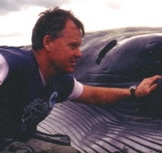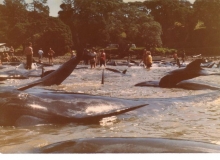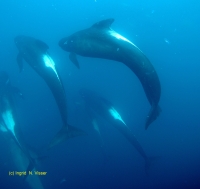During a high-spring tide at around 10.30 pm a adult and calf pilot whale swam over a shallow sandbar into the harbour. Shortly afterwards these two whales stranded and what followed was a consecutive stranding of a few more individuals. Awaiting just offshore was the main group, but as the tide rapidly dropped the whole group became stranded, leaving 143 individuals in a tight group and firmly ashore. The call was put out for help and rescue personel started arriving as soon as transport allowed. Unfortunately a few caring people had wrongly assumed that these stranded whales required water inside their blowholes which resulted in at least 30 whales being accidentially drowned.
At 0630 hrs, just after daylight, Whale Rescue team member Steve Whitehouse arrived with members from the Ministry of Fisheries (who at the time were the legally mandated authority for stranded whales). They were followed shortly by 50 members of the New Zealand Army and more local volunteers. Steve implimented the correct rescue procedures and the priority, as always, was to immediately upright the pilot whales. This was to ensure that they did not drown during the incoming tide and to allow them to regain their balance. High tide was at 0930 hrs sothe work was fast and furious, to minimize the drowning risk.
Due to the large number of whales and the relatively low numbers of rescue personnel, 19 whales managed to break away from the effort to assist them and restranded in the next bay. This resulted in the whole group having to be held until the next high tide, as the water once again rapidly dropped around those remaing animals.
The military stepped in with more personnel and basic rescue equipment such as bed sheets (which they had stripped off their own bunks on the ships) and pumps to keep the whales cool and wet.
Despite all this help, 25 whales had to be shot due to their position on the rocks and the smaller subesquent tides which would not reach them in order for them to be refloated. Additionally, this stranding was before the Rescue Pontoons had been built and their use may very well have influced the final number of animals which were rescued. However, the concept of using a 'magnet' whale to draw the others out to sea was used, where a female and calf were very carefully moved into deeper water and held whilst they called to the other members of the group.
After two days 67 pilot whales were rescued and observed as they headed out to sea. They were followed for several hours until they reached the Colville Channel. The locals were very concerned about the whales and their fate. To ensure that rescues were more successful, Steve Whitehouse returned to Great Barrier Island a few weeks later to conduct a Marine Mammal Medic training course for the residents. This training was instrumental in the extremely high success during a rescue of pilot whales in Catherine Bay the following year.
Rescue Images
Quick Facts
| Name | Pilot whale, long-finned |
| Image |
|
| Suborder | Odontoceti |
| Family | Delphinidae |
| Max. size - Male | 6.7 m (21.9 ft) |
| Max. size - Female | 5.7 m (18.7 ft) |
| Calf size | 1.7-1.8 m (5.5-5.9 ft) |
| Max. weight - Male | 2,300 kg |
| Max. weight - Female | 1,300 kg |
| Calf weight | 75 kg |
| Food | primary food is squid, but known to take fish |
| Latin name | Globicephala melas |
| Location |
Tryphena Harbour, Great Barrier Island |
| Latitude |
-36.30249 |
| Longitude |
175.47074 |
| Number of Whales |
143 |
| Number rescued/saved |
67 |
At this rescue

From a background as the NZ Whale Rescue Coordinator and a Fisheries Officer, Steve went on to design and implement both the Marine Mammal Medic (MMM) course, including full procedure manuals and the Whale Rescue Refloatation Pontoon System in the 1980s. Originally designed to train DoC staff and authorities in effective whale rescue techniques, Steve later redeveloped the MMM course for the layperson.
Read more ››
With special thanks to
Without the kind help of all the Military personel and their equipment it would not have been possible to save so many of these pilot whales.


